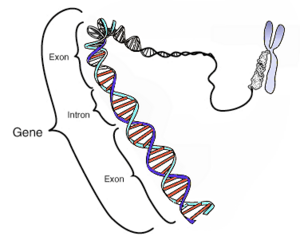Intron facts for kids
An intron is a special part of a gene that does not contain instructions for making proteins. Think of a gene as a recipe. Introns are like extra sentences in the middle of the recipe that you don't need for the final dish. They are removed before the recipe is used.
These parts are found in the DNA of most living things, from tiny bacteria to humans, and even in many viruses. The word "intron" can mean both the DNA sequence inside a gene and the matching part in the RNA copy of that gene.
The parts of a gene that do contain instructions for making proteins are called exons. These are the important bits that get joined together to form the final instructions. Exons tell the cell exactly which amino acids to use to build a protein.
Contents
What are Introns and Exons?
Imagine a gene as a long train.
- Introns are like empty carriages in the middle of the train. They don't carry any cargo (information).
- Exons are the carriages that are full of cargo (information). These are the parts that matter for making a protein.
When a cell reads a gene, it first makes a copy of the entire gene, including both introns and exons. This copy is called RNA.
The Splicing Process
After the RNA copy is made, a special process called RNA splicing happens. During splicing, the cell acts like a careful editor.
- It cuts out all the intron sections.
- It then carefully glues the exon sections back together.
This edited RNA, now made only of exons, is the final set of instructions. It is then used to build the correct protein. This whole process happens after a gene is copied (called transcription) but before the protein is actually built (called translation).
Why are Introns Important?
Even though introns don't directly code for proteins, they are very important for several reasons:
- Gene regulation: Introns can contain signals that control when and where a gene is turned on or off.
- Alternative splicing: Sometimes, cells can choose to include or exclude certain exons during splicing. This means one single gene can be used to make several different proteins! It's like having one recipe that can be tweaked to make different versions of a dish. This makes our bodies much more complex and efficient.
- Evolution: Introns might play a role in how new genes evolve over time. They can allow different parts of genes to mix and match, creating new combinations.
Discovery of Introns
The discovery of introns was a big surprise to scientists. Before 1977, everyone thought that genes were continuous stretches of DNA that directly coded for proteins.
In 1977, two scientists, Phillip Allen Sharp and Richard Roberts, independently found that genes were actually broken up by these non-coding regions. They shared the Nobel Prize in Physiology or Medicine in 1993 for their groundbreaking discovery. The term intron was first used by an American biochemist named Walter Gilbert.
This discovery completely changed how we understand genes and how they work in living organisms.
See also
 In Spanish: Intrón para niños
In Spanish: Intrón para niños


